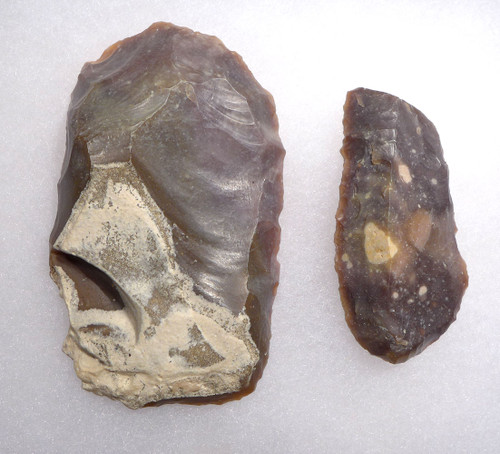Product Description
SEE MORE AFRICAN NEOLITHIC TOOLS AND ARTIFACTS
This CAPSIAN NEOLITHIC flake tool was found on an exposed African Neolithic site in the Sahara Desert of Northwest Africa. It was masterfully fashioned by African Neolithic humans (Homo sapiens sapiens) between 10,000 and 4,700 years ago. This Neolithic artifact is of the finest quality, far superior to typically seen stone tools of the era and region. It was hand-selected from thousands of incomplete and inferior specimens. In over the last two decades, poor safety and security in the desert, as well as changing laws in North Africa, prevent any new collecting or discoveries to be made, making these artifacts increasingly desirable and valuable.
Made of tabular flint with its unique characteristics incorporated into the tool, there are many artistic features that just make this specimen stand out from all the others. First, it is much larger than typical scrapers - nearly twice the average size! It was made of tabular flint and the white natural cortex outer layer was retained, being used for an ingenious grip for the thumb, as shown in the photo. The tabular flint is made of layers and these layers have taken on varying colors which come through in the entire perimeter of the tool showing banded hues! Flaking runs all round the sides and end. This is a UNIFACIAL COMBINATION END AND SIDE SCRAPER. The rounded end shows expert flaking to make a perfect hemisphere. Both sides show expert secondary flaking to create and resharpen a long cutting edge. This tool is complete as originally made and possesses a natural sheen called "Desert Varnish" caused by the effect of the wind and sand polishing the surface after being exposed for thousands of years on the desert floor. It exhibits the highest degree of skill in workmanship. The color and patina are especially fine, its beauty surpassing all commonly found tools.
 US DOLLAR
US DOLLAR
 EURO
EURO
 AUSTRALIAN DOLLAR
AUSTRALIAN DOLLAR
 CANADIAN DOLLAR
CANADIAN DOLLAR
 POUND STERLING
POUND STERLING




















